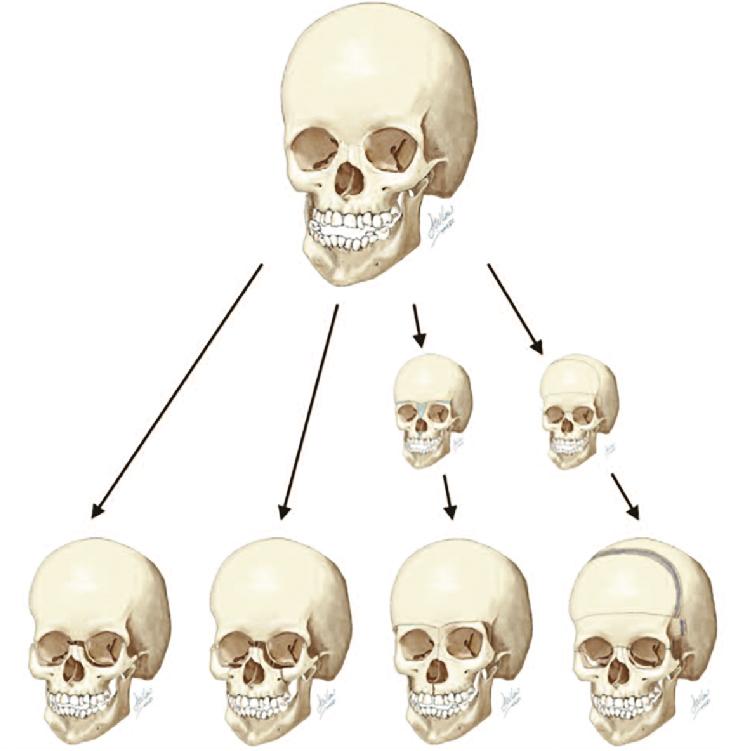Physical Address
304 North Cardinal St.
Dorchester Center, MA 02124
The care of children with syndromic craniosynostosis is complex and multifaceted, and surgical interventions are a critical component of treatment and an opportunity to provide significant functional and aesthetic improvements in these patients. The use of computer-assisted design and computer-assisted manufacturing (CAD/CAM) in surgery for children with syndromic craniosynostosis has aided in the performance of increasingly complex operations, and while improved functional and/or aesthetic outcomes directly attributed to the use of computer-assisted surgical planning (CaSP) has not been definitively identified, many experienced craniofacial surgeons would agree that accuracy, precision, and speed of an operation are increased with the use of CAD/CAM. CaSP can be especially valuable in patients with syndromic craniosynostosis due to multivector distortion of bony craniofacial anatomy, variation of anatomy between individual patients, and abnormalities due to previous operations. There are multiple operations frequently performed in children with syndromic craniosynostosis that, in most settings, do not typically warrant the use of CaSP (frontoorbital advancement, posterior cranial vault distraction, single-piece Le Fort II and Le Fort III osteotomies). However, a more complex subset of “customized” operations for children with syndromic craniosynostosis is well-suited for digital planning, including multipiece, multilevel, multivector midfacial or frontofacial surgery. The ability to design these customized, complex osteotomies and surgical plans represents one of the strengths of CaSP, perhaps extending the “completeness” of correction of each individual’s dysmorphic anatomy.
In this chapter, we provide an overview of the use of CAD/CAM in syndromic craniosynostosis, and specifically of its role in planning and executing multipiece midfacial and cranial operations. Considerations in the choice of frontofacial osteotomy and specific procedures will be discussed, along with steps for CaSP and considerations for selecting custom cutting guides, plates, and splints. Operative technique, pearls, and outcomes are summarized, and specific scenarios in which the authors recommend the use of computer-assisted surgical planning are reviewed.
The choice of midfacial operation in children with syndromic craniosynostosis is complex and dependent upon the anatomical and functional goals of an operation in an individual patient. High-level considerations for each individual patient include the relative necessity for (1) expansion of the cranium to prevent or treat increased intracranial pressure and (2) correction of abnormal anatomy of the midface, orbits, and frontal skull. With these two overarching goals in mind, specific features to consider that can be addressed in a single operation include the position of the frontal bar, presence of exorbitism, need for rotation of the orbits, degree of hypertelorism, need for expansion of the cranium, extent of central versus peripheral hypoplasia of the midface, nasal length, degree of anterior open bite, maxillary dental arch width, and presence of obstructive sleep apnea. , The presence of certain single anatomic features may dictate the necessity of a single operation; for example, only a facial bipartition can achieve midfacial advancement and closure of a V-shaped anterior open bite in a single operation. Other features such as palpebral fissure rotation, midface lengthening, and cranial expansion can be achieved by one of several osteotomy designs, and the choice of specific operation will be dependent upon any given patient’s anatomy and surgeon’s experience and comfort level. The expected clinical alterations of each level and design of midfacial osteotomy are shown in Fig. 11.1 . The following workflow and technique discussions are intended to be applicable to patients in whom a multipiece frontofacial operation is chosen (i.e., monobloc advancement with or without facial bipartition). Le Fort III and Le Fort II with zygomatic repositioning, while included in the algorithm shown in Fig. 11.1 , are discussed elsewhere in this textbook.

Prior to a CAD/CAM session CT imaging is obtained, and the patient’s CT scan is transferred to the surgeon’s vendor of choice for upload into their planning software and preparation for manipulation by the vendor’s engineers. Specific CT protocols have been previously described in the literature regarding the imaging characteristics required for CAD/CAM, but ultimately vary dependent upon the vendor chosen for CaSP; thus, these specific requirements should be reviewed prior to obtaining imaging. While dental models or scans are typically required for patients in adult dentition and/or at skeletal maturity, they are not typically required for patients undergoing midface surgery prior to skeletal maturity. They may be utilized in settings in which addressing the maxilla-mandibular bony relationship and occlusion are the primary goals of an operation even with a patient in mixed dentition (i.e., rib graft for hemifacial microsomia in a child).
Multiple items are available for commercial production and are of varying utility for specific cases. In midfacial surgery in syndromic synostosis, cutting guides are generally the most useful item available via computer-assisted surgical planning (CaSP), and can be used to guide bony resections, design osteotomies in specific configurations and with specific goals (i.e., customized movement of the orbits, zygomas, and so forth), or to place distractors at a predetermined vector. Custom plates are available but less frequently used for patients at skeletal immaturity and undergoing distraction osteogenesis. In a situation in which a patient is undergoing an acute midfacial movement, custom plates can be considered and may be helpful to have produced in order to confirm a specific degree or distance of movement. Finally, acrylic skull or midfacial models can be fashioned to mirror a patient’s preoperative or postoperative intended position. Postoperative acrylic models can be useful to prebend stock titanium plates to fit a patient’s intended postoperative bony position, which can be used as an alternative to custom-milled plates. Resorbable fixation can also be bent to fit an acrylic skull model for patients considered too young for titanium fixation.
Become a Clinical Tree membership for Full access and enjoy Unlimited articles
If you are a member. Log in here